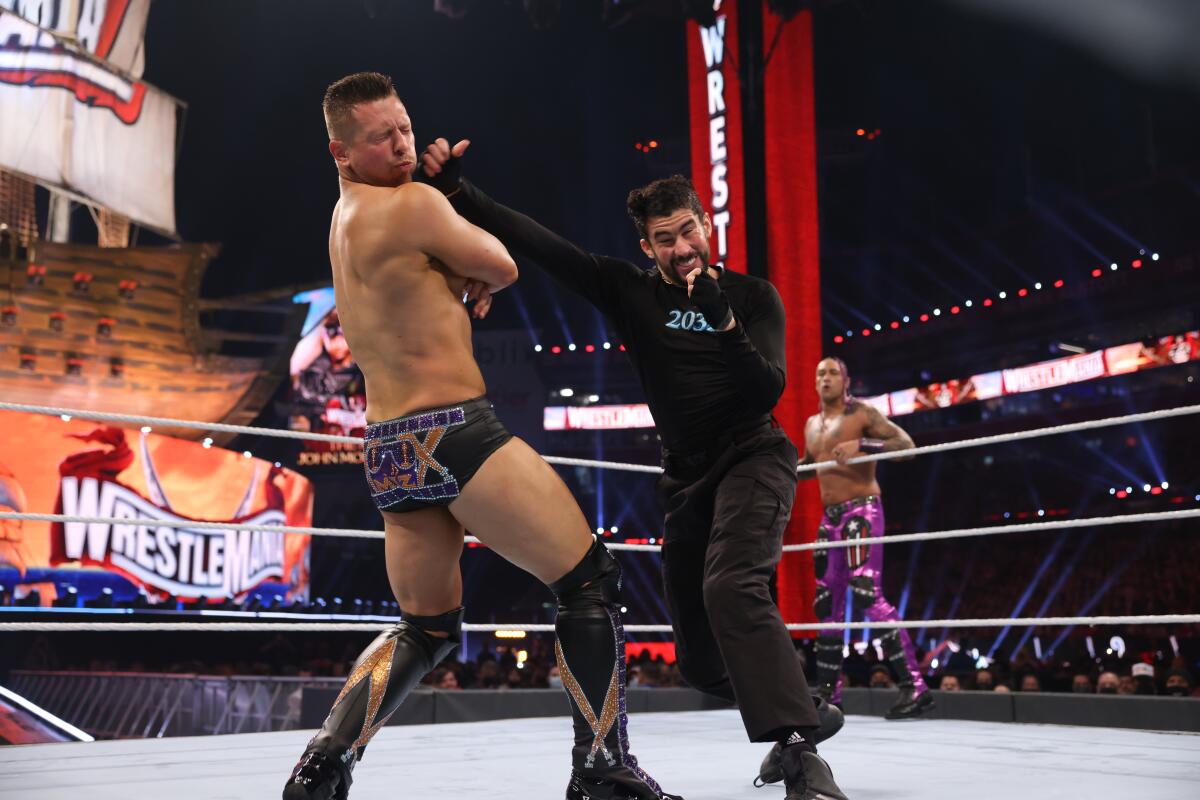Op-Ed: What WWE and pro wrestling could teach struggling media companies

- Share via
World Wrestling Entertainment’s “Monday Night RAW,” the longest running weekly episodic TV show in the U.S., just celebrated its 30th anniversary.
Whatever you might think about the world of professional wrestling and outdated stereotypes like “it’s fake,” that kind of longevity should be instructive to the media institutions struggling for audience retention and cultural relevancy.
In recent weeks, legacy media companies have been bombarded with a series of brutal benchmarks. “CNN Just Suffered Its Worst Ratings Week in 9 Years” was a headline last week in TheWrap. “The Washington Post Lays Off 20 Staffers” was the news in Vanity Fair. “More Than 70 Staffers Laid Off Across NBC News and MSNBC” reported Adweek.
Meanwhile, the 30th anniversary episode of “Monday Night RAW” drew 2.34 million viewers, the WWE’s highest rating since March 2020. I saw the event in person in Philadelphia last week and I was struck by how much passion and emotion the show brought out in the sold-out crowd of more than 15,000. Every demographic you can think of was represented. Old, young, parents, children, white, Black, Latino, Asian-American. It didn’t surprise me when a WWE spokesperson told me that its franchise has the highest percentage of non-white fans of any major sport.
WWE is unusual because it has the ability to bridge generations. In one night, we saw 80s cultural icon Hulk Hogan, 90s counterculture heroes DX, the return of “The Beast Incarnate” Brock Lesnar, the GOAT Ric Flair, and the most relevant superstar of the decade, “Head of The Table” Roman Reigns.
If you pay attention to sports, music, film and television or pop culture, at least one of these names means something to you. WWE is the ultimate factory for showcasing conflict and drama — telling the story of good and evil with their heroes and villains. At times though, those lines have blurred and storylines became more complicated, the villains became the heroes, the fans cheered for the “bad-guys” and booed the “good guys.” Then WWE faced a simple choice — lose their audience to the competition or evolve. Embracing this change in cultural trends, WWE ushered in what was known as the “Attitude Era,” with more realistic characters like “Stone Cold” Steve Austin and “The Rock.” The result was greater audience response, with “Monday Night Raw” drawing record ratings and more than 5 million viewers a week.
Today’s media institutions confront a similar quandary. How to connect with audiences that are accustomed to seeing a narrative play out. In many ways, the notion of presenting “both sides” of an argument now feels less relevant and more contrived than ever. The audience can tell right away when someone is an artificially “objective” narrator. There’s a reason why nobody cheers for the referees.
We live in a complex world that is emotional, unpredictable, dramatic, flawed, diverse and constantly changing. If media companies can’t offer that representation to their audience, their audience will find it somewhere else.
When Dwayne “The Rock” Johnson debuted on WWE, the fans booed him out of the building, holding up signs and chanting “Die Rocky Die.” Even though he was cast as a “good guy,” the audience just wasn’t having it and they turned on him immediately. It wasn’t until he showed his true self, his wit, humor, sarcasm, ego, that the fans began to embrace him.
Of course, there are plenty of people in the media industry who show their personalities, reveal what frustrates them and what encourages them, who are their true selves. They are unafraid to tell the truth and have built loyal followings over the years because the audience trusts them and perceives them to be authentic. Contrast that with the propagandists at Fox News who tell their audience one thing, but privately believe the opposite, as we saw via the text messages that came to light via the House Jan. 6 Committee’s investigation.
The industry consensus is that traditional TV programming and legacy media are dying, and the next generation of consumers is leading the exodus. Media companies face the same challenge WWE has faced over the years — adapt or die.
WWE has passed that test over and over again because it embraced the audience’s feedback. Similarly, truth-telling media must continually evolve in how they master the art of reporting the facts while telling the story. For on-air media, they need to form an emotional connection with the audience, to earn their trust and become a destination where they get the facts — most likely in that order.
Kurt Bardella is a contributing writer to Opinion. He is a Democratic strategist and a former senior advisor for Republicans on the House Oversight Committee. @KurtBardella
More to Read
A cure for the common opinion
Get thought-provoking perspectives with our weekly newsletter.
You may occasionally receive promotional content from the Los Angeles Times.










